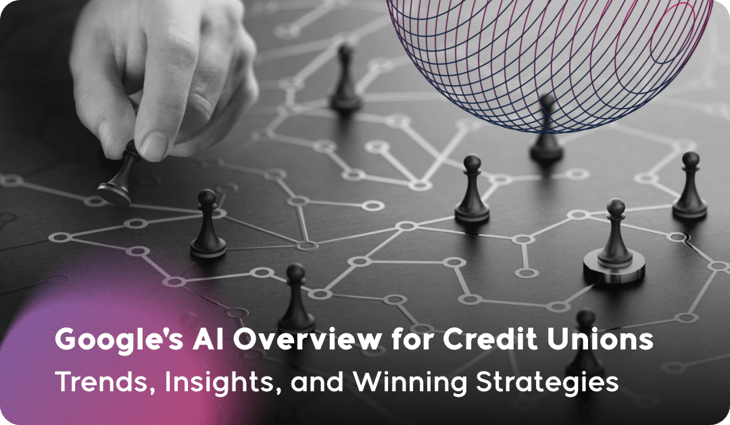Formerly WebStrategies, Inc.
Google AI Overviews for Credit Unions - What’s Changed Since Our February Report?

Nick D'Amato
May 13, 2025

Back in February, we shared a detailed breakdown of Google’s AI Overviews and how they were affecting search visibility for credit unions. That blog gave marketers a baseline understanding of how often these AI-generated summaries appear in the SERPs, and what you can do to appear in them.
Now, after three more months of tracking, we’re back with new data, refined insights, and a clearer understanding of how credit unions can win in this evolving SEO landscape.
📌 Didn’t read the original post? Catch up here
Quick Recap: What Are AI Overviews?
Google’s AI Overview (also called the AI Snapshot) is an AI-generated summary that appears at the top of some search results. It provides fast, citation-backed answers pulled from various websites, often accompanied by follow-up questions and resource links.
In February, we reported that:
- ~40% of credit union-related search terms triggered an AI Overview.
- “Versus” and “What is” queries were most likely to trigger an AI Overview.
- Page-one rankings increased your chances of being cited, but weren’t the only path to inclusion.
So, what’s new?
1. Page One Rankings Are Still Valuable, but AI Overviews Are Evolving
We’re now seeing 30.57% of links cited in AI Overviews also rank on page one. This is a slight drop from the 45.31% we reported earlier in the year.
![AI Overview Test [CU Only] (3)-1](https://www.geear.io/hs-fs/hubfs/AI%20Overview%20Test%20%5BCU%20Only%5D%20(3)-1.png?width=730&height=411&name=AI%20Overview%20Test%20%5BCU%20Only%5D%20(3)-1.png)
What This Means:
Google is pulling from a wider pool of sources, including sites that may not be in the top 10 results. So even if you’re not yet ranking on page one, you still have a chance to be cited, especially if your content answers a sub-topic comprehensively.
2. If You Are on Page One, Your Chance of Citation Has Increased
This second metric flips the perspective: of all the results on page one, how many are included in AI Overviews?
Right now, 35.22% of page-one results for credit union keywords are also cited in an AI Overview, a modest increase over previous months.
![AI Overview Test [CU Only] (4)-1](https://www.geear.io/hs-fs/hubfs/AI%20Overview%20Test%20%5BCU%20Only%5D%20(4)-1.png?width=960&height=540&name=AI%20Overview%20Test%20%5BCU%20Only%5D%20(4)-1.png)
Key Takeaway:
If you’re ranking on the first page, your odds of getting cited in an AI Overview are stronger than ever.
3. “Versus” and “What Is” Queries Still Dominate
Our latest keyword tracking confirms what we saw earlier this year: certain search intents are more likely to trigger AI Overviews.
![AI Overview Test [CU Only] (5)](https://www.geear.io/hs-fs/hubfs/AI%20Overview%20Test%20%5BCU%20Only%5D%20(5).png?width=960&height=540&name=AI%20Overview%20Test%20%5BCU%20Only%5D%20(5).png)
Most Likely to Trigger an AI Overview:
- 100% of “Versus” queries (e.g., credit union vs. bank) triggered an AI Overview.
- 80% of “What is” queries also led to one.
Less Likely (But Still Worthwhile):
- 40% of “How to” queries
- 25% of “Best” queries
These lower percentages, especially for “best” and “how to,” likely reflect Google’s caution around financial advice. Worth noting that the AI is happy to explain what something is, but more hesitant to tell you what to choose, especially in sensitive financial contexts.
January vs. May: What’s Changed?
We first published our findings on AI Overviews for credit unions in early February 2025 with data through January 2025. Since then, a few key metrics have shifted, some slightly, others more notably. The most significant change we’ve seen is the number of links in these AI Overviews. See below:
|
Metric |
January 2025 |
May 2025 |
What It Means |
|
Average # of links in an AI Overview |
6.74 |
11.52 |
More links in AI Overviews offer more opportunities to get cited. |
|
% of AI Overview links also ranking on page one |
45.31% |
30.57% |
A dip. Google is pulling more links from beyond the top 10 results. |
|
% of page-one results cited in AI Overviews |
30.53% |
35.22% |
An increase, a first-page ranking now gives you better odds of citation. |
|
AI Overview frequency for “Versus” queries |
100% |
100% |
No change, still the most consistent format to trigger an AI Overview. |
|
“What is” query AI Overview frequency |
80% |
80% |
No Change, informational queries remain strong performers. |
|
“How to” query AI Overview frequency |
60% |
40% |
Slight decline, suggests Google is pulling back from instruction-heavy advice. |
|
“Best” query AI Overview frequency |
12.5% |
25% |
Lower than before. Google continues to avoid ranking “best” financial products directly. |
Strategic Takeaways for Credit Union Marketers
1. Don’t Sleep on Page One
Ranking in the top 10 results gives you a 35%+ chance of being cited in an AI Overview. Keep optimizing for traditional SEO, but know that relevance and structure matter, too.
2. Target “Versus” and “What Is” Content
These formats remain the highest-performing triggers for AI Overviews. Build blog content, comparison pages, and FAQ-style answers around these query types.
3. Write for Subtopics and Follow-Up Questions
Even if your page isn’t ranking #1, you might still be cited. Google’s AI is trying to answer your query and your next query. Building content around related queries increases your chances of getting cited.
4. Stay Cautious with “Best” and “How To” Topics
These still hold value, especially for brand visibility and organic traffic. However, when it comes to AI overviews, Google’s reluctance to offer financial advice makes these topics less likely to be featured.
Final Thoughts
While things will continue to shift, our data suggests AI Overviews for credit union-related terms have stabilized in their behavior and frequency in many ways.
The takeaway? Be proactive, not reactive. Build strong content around known trigger formats and track how your pages perform in both traditional rankings and emerging AI surfaces.
As always, WebStrategies is continuing to monitor these trends monthly and will keep you informed with future updates.
If you’d like more details on the data Nick presented or want a tailored approach for your credit union, contact us today. We’ll walk you through how to optimize your content for the new era of AI-driven search results.

Ready for marketing that actually delivers?
Let's build something measurable together.
 Talk to the Team
Talk to the Team